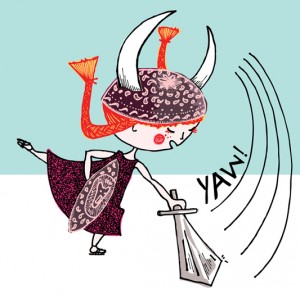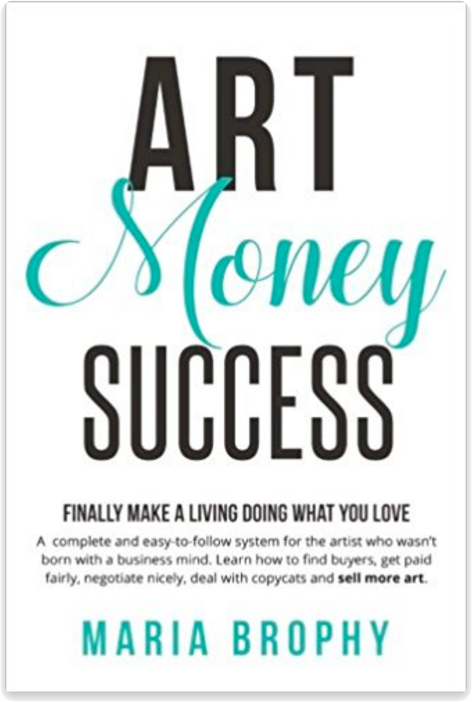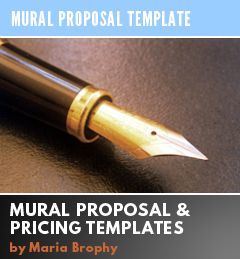
(Artwork provided by the wonderful, fun and talented Sara Jane Franklin.)
When you need to have your sink unclogged, there’s little difference in price from plumber to plumber. I think that at one time in the past, the wise plumbers got together and said “let’s all charge the same high price so we all get paid well!”
If only artists could do the same, then pricing would be so much easier!
In the art business, while one creative can garner $10,000 for a painting, another can only get $500 for the same size and medium.
Many artists have a hard time financially because they just don’t know what to charge.
Often, artists will turn down a good opportunity because they are paralyzed by the fear of making a mistake and charging too little.
And when it comes to licensing your art, there are many different ways to be compensated.
Licensing Art means – you retain all copyrights © to an image, and license, or “rent”, the art to someone for either a one-time use, such as in a magazine or advertising campaign, or for a longer term use to print on products, such as a t-shirt line or pottery, greeting cards, etc.
(For more on art licensing: sign up for my FREE ten week series called “ART LICENSING MADE EASY” which teaches how to license your art, negotiate contracts and know what to charge $$$. SIGN UP HERE! )
FEAR THE LICENSE DEAL NO MORE – I promise you that once you begin to understand how these things work, you’ll feel more confident with deal-making.
With confidence comes more deals, and no more lost opportunities. So please, read on!
The most common methods of pay for art licensing are:
1 – ROYALTY: This is where the manufacturer pays the artist a royalty percentage of their gross sales.
2 – ROYALTY WITH ADVANCE UP FRONT – Sometimes there will be an advance payable up front, which is later deducted from future royalties.
3 – FLAT FEE – A one-time fee is paid instead of royalties.
Okay, but how much moola do you ask for?! Below are a few guidelines:
ROYALTY PERCENTAGE PAYMENT:
Before we get to the topic of how much to ask for, let’s make sure you understand how royalties work.
Royalty payments are calculated based on the total (gross) revenues generated by the licensee (manufacturer) for your products.
Red Flag Warning: Never agree to get paid your percentage based on the Licensee’s revenues minus their expenses. This is an impossible number to quantify.
ROYALTY RATE EXAMPLE: Let’s say that you have agreed to license your art to Perry Pickle Manufacturing for t-shirts. They plan to sell the t-shirts to a chain of stores called Racey’s. You have agreed to a royalty rate of 6% with a $3,000 Advance up front.
This means that Perry Pickle Mfg is going to pay you 6% of their total gross revenues generated. Since they agreed to pay a $3,000 Advance up front, they paid you the advance at the time that the contract was signed.
In their first quarter, Perry Pickle Mfg received $100,000 in revenues for t-shirt sales of your line to Racey’s.
That means that you would receive a royalty payment of $6,000.00 ($100,000 x 6% = $6,000.00), MINUS the advance of $3,000.00 up front.
The advance is “recoupable against future royalties” so your first royalty payment would be the $6,000 minus the advance amount of $3,000, and you would have been paid $3,000.00.
Okay, now let’s talk about how you arrived at the 6% royalty rate:
ROYALTY RATES DEPEND ON SEVERAL DIFFERENT FACTORS, THE 3 MOST IMPORTANT:
- The TYPE of product being produced
- The QUANTITIES expected to be sold
- The POPULARITY (STRENGTH) of the artist or brand
THE FIRST FACTOR IN DETERMINING ROYALTY RATES is the type of product being produced. The average royalty rate varies from product to product.
For example, the average rate for art lithographs ranges between 5% – 15%, compared to 3 – 6.5% for wristbands. The average royalty rate is a good starting point for determining what the rate should be.
There are a few resources that will help you learn what the average royalty rates are, such as artists groups and reference books.
To find out what others are being paid, connect with artists who are experienced in licensing through online forums and groups such as Linked In. Ask the members what the average royalty rates are, in their experience, for a particular product. These groups can be very helpful.
THE SECOND FACTOR IN DETERMINING ROYALTY RATES is the expected (or projected) sales volume.
The higher the volume, the lower the royalty: If the products will be sold in mass market retailers and in mass quantity, the royalty rate will be less because mass market retailers (like Wal-Mart, Costco) demand better prices, which means tighter profit margins for the manufacturer.
Usually, an artist will earn more money from a lower royalty rate when products are being sold in mass market, than they would with a higher royalty rate for products being sold in small mom and pop shops.
The lower the volume, the higher the royalty: If the products will be sold in specialty stores and in smaller quantities, the royalty rate should be higher.
For example: A t-shirt manufacturer that sells in mass market stores (Wal-Mart, Target, chain stores) might pay 4-6% royalties. A t-shirt manufacturer that sells in smaller channels such as core skateboard shops might pay 6-10% royalties.
If the artist is well known and their art is a proven seller, the royalty rates would be on the high end of the scale. If the artist is unknown and new to licensing, the royalty rate might be on the lower end of the scale.
In some cases, a licensee that works with artists on a regular basis will have a standard royalty to offer to you. At that time, you can decide if you want to accept their offer, or negotiate for more
FLAT FEE PAYMENT: A flat fee is a lump sum that is paid up front at the time the contract is signed. There are no royalties that will be paid later.
Flat fees may be calculated by image (i.e. $500 per image x 10 images = $5,000); or they may be paid in one specified sum (i.e. $2,500 total).
The flat fee method is best when the licensee is either a small company that does low volume, or is a start-up company that does not have a track record of sales.
The disadvantage to a flat fee royalty is that if the product sells above expectations, you may be missing out on sharing a piece of those revenues.
The best way to protect against the possibility of missing out on a piece of a great selling product is to have a short term, such as a one year or eighteen month contract.
With a shorter contract, if sales are very good, the licensee will want to renew, at which time you will be paid again, or you can negotiate for a better deal.
How much of a flat fee should you ask for? Like all deals, the range is wide. I know of some artists who charge as little as $100 per image for a flat fee license. In the greeting card industry, an artist might be paid a flat fee of $275 – $500 for a card design. I’ve had deals in the action sports market where I charged a flat fee of $1,500 per image, with a price break if they license multiple images.
The flat fee amount that you get will depend upon: 1- the strength of your brand, 2 – the competition in the industry and 3- what the licensee is willing to pay.
The most important thing is that you get paid what you feel that your art is worth and that you are happy with the end result.
ADVANCES: An advance is a dollar amount that an artist is paid up front, due at the time of signing the contract. The advance is usually non-refundable, and is deducted from future royalty payments.
What I love about advances is the most obvious: you receive a payment up front.
Often in licensing deals, you won’t see royalties for a year or more because it takes that long to develop a line, sell it and get it shipped to stores. The advance is money NOW, which is when most of us need it.
I use the advance as an insurance policy should something go wrong. It hedges against the possibility that there will never be royalties paid in the future, because if a company is willing to pay an advance, than that means they are committed fully to the product sales. Without commitment, sales often won’t happen. Sometimes the products never make it to the marketplace or are dropped from the line.
And that means No sales which means No royalties.
The main reason we almost always require an Advance for Drew’s work is that it helps me to weed out the serious people from the not-so-serious.
If a company is willing to pay us an advance, I’m more convinced of their commitment to the success of the product sales.
Red Flag Warning: If the deal you are about to enter into is going to require an excessive amount of work on your end, it’s crucial to require an advance or a design fee to cover your time. That way, you don’t have to wait the 12 months or so that it takes for royalties to generate before you get paid.
Since there is no guarantee that a license will generate any royalties at all, an advance is insurance that you’ll be paid something in the event anything goes wrong.
What could go wrong, you ask?! The client is so excited and they plan to put a lot of effort into the line.
One personal example is when we did a deal with one of the largest toy companies in the U.S. They went bankrupt one month after we gave them the artwork for a kid’s skateboard line. Drew had spent weeks working on it. Thank God we were paid a generous advance so that Drew’s time was covered.
Another time we signed on with a kid’s clothing company. They had their Drew Brophy line ready to go, after weeks of work on our end. Then a new partner came in and changed everything. The line never made it to retail and no royalties were generated. We had been paid an advance up front, so we didn’t lose a month’s worth of work for nothing.
The flip side to all of this is that for every deal that isn’t successful, there’s one that is successful. You have to sign on with many companies because some will be duds and some will be good.
Remember, there are no set-in-stone pricing structures for licensing or for art deals. You have to be creative and come up with a deal that works for you and for your client!
Maria
PS: Read “Beware of these Red Flags in Contracts“ for more food for thought.
Would you like your own licensing agreement template that you can use again and again? My new LICENSING AGREEMENT/CONTRACT TEMPLATE PACKAGE is now available. This package makes it easy for you! Complete with a template that you can change as needed, and instructions, this is the perfect short, simple agreement for artists not yet ready to hire an attorney. More details here: Licensing Agreement Contract/Template















